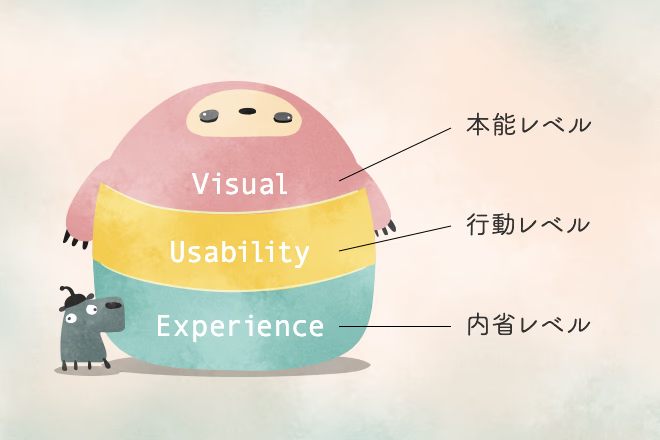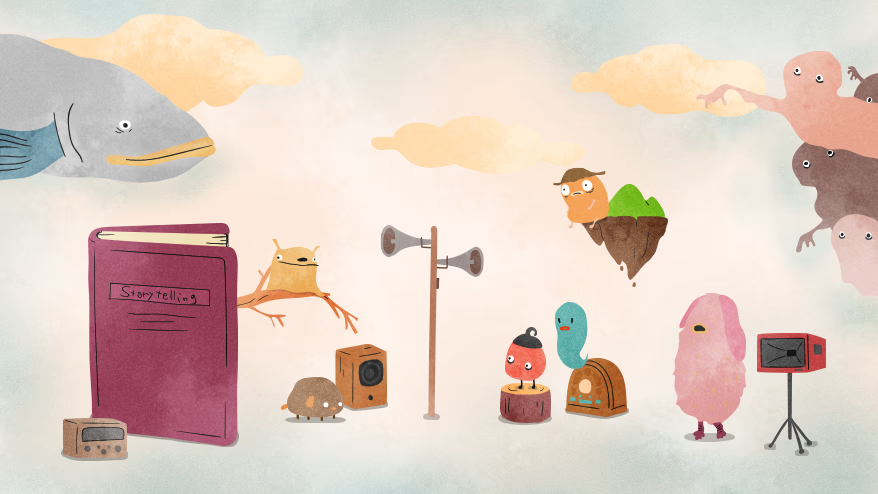こんにちは。デザイナーの滝田です。
最近「デザインはストーリーテリング 『体験』を生み出すためのデザインの道具箱
」という本を読んでみました。
現代は制作物を含めたプロジェクト全体をデザインしていくことが求められているという前提のもと、「物語(ストーリー)」をキーにしたデザインの知識や手法をコンパクトに紹介してくれています。
そもそも「ストーリーテリングデザイン」ってなんなの?という方に簡単に説明しますと、
製品やブランドの背景にある思いや伝えたいコンセプトを、それを想起させる印象的な「物語」を使うことで、ユーザーに強い印象を与える手法のことです。
ストーリーの種類は、さまざま。
ユーザーがサービス利用時の姿を想像してもらいやすい物語になっていたり、製品の制作過程の様子をストーリー化しているものもあります。
「ストーリーテリング」というワードは、2016年ごろからWebデザインのトレンドとしてあちこちのサイトで目にするようになりました。スマートフォンやタブレットの普及により、シングルページのデザインが増え、それと相性の良いストーリーテリングデザインが人気になっていったという流れです。また、ストーリーテリングデザインは、動画やパララックスなどのアニメーション効果とも組み合わせやすく、縦長の1ページを飽きさせない工夫の1つとして取り入れやすいという事情もあるかと思います。
上記の通り、なぜ「ストーリーテリングデザイン」がWebデザインのトレンドとなったのか、制作側の理由は十分に頷けるほど理解できました。
でもそれって、見る側(ユーザー)に対してどんな効果があるの?
どうして「ストーリー」で見せることによって、強い印象を与えることができるの?
そんな疑問も湧いてきます。
今回は、「ストーリーテリング」の効果について気になって調べてみたことを、自分の理解を深めるためにもまとめてみようと思います。
記憶に残りやすい
まず一番はじめに、ストーリーがあることで、製品情報や伝えたい内容が圧倒的に人の記憶に残ると言います。
スタンフォード大学のマーケティングおよび心理学専門の教授、ジェニファー・アーカー氏の研究によると、ストーリーがあることで、事実や数値の羅列よりも最大で22倍記憶に残りやすいと明らかになっているようです。
(参照: https://womensleadership.stanford.edu/stories)
22倍という数字は驚きですが、魅力的なストーリーに没入している状態で入ってくる情報が記憶に残りやすいということは納得できます。
むずかしい専門外のテーマを目の前にした場合、情報やデータをただ羅列されるよりも、感動的な小説や映画などの中から入ってきた内容は、あとあと残る情報量も多いように感じます。
得られる共感が深い
人は、よい物語や共感できるストーリーに触れると、オキシトシンというホルモンが増加する傾向にあるそうです。いわゆる「幸せホルモン」や「愛情ホルモン」と呼ばれるオキシトシンですが、信頼、思いやり、共感のような「人と人とのつながりを強める」「愛着を形成する」働きがあります。
カリフォルニア州にあるモント大学院大学の研究員である、ポール・ザック博士の実験に、「共感とオキシトシン」の関係について、こんな実験が行われていました。
(参照:経済は「競争」では繁栄しない 信頼ホルモン「オキシトシン」が解き明かす愛と共感の神経経済学)
被験者を2グループに分け、それぞれ別の100秒間のビデオを見せます。
- Aバージョンは、父と幼い息子が動物園で楽しいひと時を過ごしている映像
- Bバージョンは、脳腫瘍の息子との絆について涙ながらに語る父親の映像
その結果、Aバーションを観た人は血中のオキシトシンレベルが20%も下がり、Bバーションを観た人は基準値から47%も上がったそうです。
この実験によると、実際目の前に困っている人がいなくとも、映像として映し出された「ストーリー」を通して登場人物に共感を示し、オキシトシンが分泌されたということです。
(ちなみにAバーションを観た人の数値が下がった理由として、おそらく感情移入して共感する部分が低いため、観ている途中で退屈して興味を無くしたのだろうと本書では結論づけられています)
完全な余談ですが、オキシトシンの分泌量が美肌にも関係しているそう。ガシガシ分泌しておいて損はないみたい。
(参照: https://www.syogyo.jp/news/2018/07/post_021771)
ストーリーは物事の理解をスムーズにする
認知心理学の第一人者であり、「認知と情動の3つの処理レベル」を提唱するドン・ノーマン氏をご存知でしょうか。ノーマン氏は、認知と急激な感情の動きである情動には、三つのレベルがあると言います。

本能レベル
そのデザインが良いか悪いか、好きか嫌いかなど直感的な見た目に対しての反応。
行動レベル
「スクロールをする」「ボタンを押す」などの行動をした時、期待していたフィードバックが得られるかなど、わかりやすいか使いやすいかなどの反応。
内省レベル
後から思い返したり、熟考したりして、自分にとってそのデザインがどんな価値を持つかを評価するような反応。(サイトの機能面に多少不満があるが、好きな俳優や推しのアイドルがイメージモデルで、その人の良さを引き出す写真が多数掲載されていたら、総合的な評価や満足度は高くなる。つまりはそういうこと)
※注 こちらは「認知と情動の3つの処理レベル」をWebデザインをみた時の反応に例えて、わたしなりの解釈でサクッと説明したものになります(だいぶ個人的な見解が含まれている可能性があるので、ちゃんと知りたい人はぜひ下記の本を読んでみてください)。
(参照:誰のためのデザイン? 増補・改訂版 認知科学者のデザイン原論)
彼の著書にはこんなことが書かれています。
人間は生来、ものごとの原因を探したり、説明や物語を作り上げるようにできている。
本書では、人は何か新しい出来事や物事に直面した時に、説明を探そうとして頭の中で「概念モデル(物語)」を作り出し、その出来事の理解に用いるといいます。
「概念モデル」は、それまでの自分の体験であったり、他者の話であったり、またはそこから形成される一般論に帰属するのですが、これら過去の物語と因果関係が一致しない場合でも、人は何かしら一つを割り当てようとするそうです。
そして足りない部分を補うための想像力を働かせ、自分が観察したことを説明する物語(概念モデル)を成形するのだと記されています。
なんだかむずかしいので、はじめてUIデザインアプリの Sketchを使った時の私に例えてみます。
「全部英語でわからない!どうやって使うの?」(新しい出来事)
↓
「とはいっても、XDは使ったことがあるし、操作が似ていると聞いたことがある...」(過去のストーリー・他者の話・一般論を割り当ててみる)
↓
「え?でも◯◯なんて名前の機能は、XDになかった。。なんだこれは?」(過去のストーリーとは一致しない部分)
↓
「うーん、おそらくこれは△△△するための機能だろう」(想像力で足りない部分を補う)
↓
それにより「よし、あってた!上手くいった」
(過去のストーリー+想像力で、新たな概念モデルが誕生。それによってSketchの機能を使うことができた)
なんとなく想像できたでしょうか?
つまり人間は「物語」を通して物事の理解を進めたり、自分で新たな物語を作って理解をスムーズにしたりしているという考え方です。
これからも知識を深めたい
「ストーリーで伝える」ということ
自分の経験においても「ストーリー」を通して情報を知ることで理解しやすかったり、記憶に残りやすかったりしているなと改めて思いました。
科学的な情報が飛び込んでくると、根っからの文系人間と思い込んでいる自分としてはとても手が出しずらいと思ってしまいます。
しかしその入り口が、おもしろそうな映画やゲームだと、導入がスムーズになり、楽しむことができたりします。
また興味が持てたことで、結果的に後に残る情報が多くなるということは、私自身、確かに経験があると思いました。
もちろん「ストーリーで見せる・伝える」という方法は、聞き手の解釈に左右される部分が大いにありますし、逆に数値化されたデータで読ませた方がいいもの、情報を整理して箇条書きで見せた方がいいものもあります。
Web制作においても同じことが言えますし、ストーリーを使うにしてもテキスト・グラフィックで見せた方がよい場合も、動画で見せた方が効果的な場合も、表現方法はさまざまだと思います。
こうしていろいろと興味が飛躍して調べてきましたが、「ストーリー形式で伝える」ということが、人間の認知的な特性から考えると効果的な方法の一つであると知ることができました。
デザイナーとして「見せ方」「伝え方」を考える上で、こういった知識は今後も深めていきたいですし、学んだことをアウトプットまで繋げていきたいと思います。
